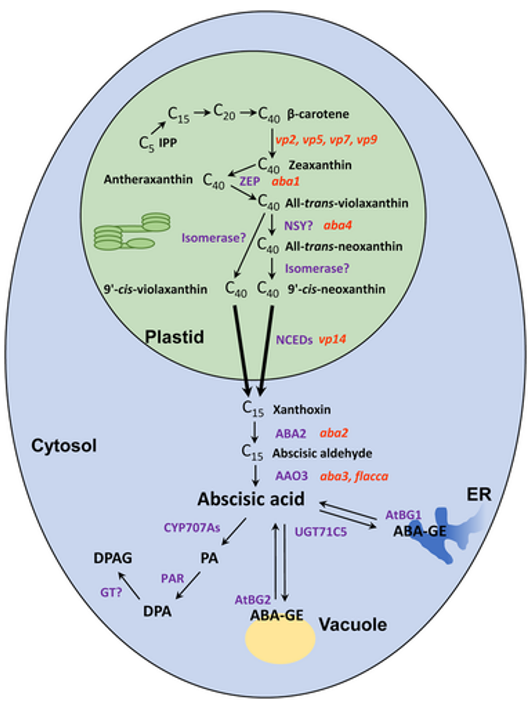v-innovate Technologies is proud of offering abscisic acid (ABA) analysis in plants using LC-MS/MS techniques. Our team has the experience and knowledge in detecting and quantitating various plant hormones. All assays are consistent with regulatory requirements and governed by SOPs.
Abscisic acid (ABA) is an important isoprenoid phytohormone regulating plant growth, development, dormancy, germination, root architecture and major stress responses. ABA is involved in various physiological processes of plants ranging from stomatal opening to protein storage. ABA controls downstream responses to abiotic and biotic environmental changes, such as drought, salt, and cold stresses, through both transcriptional and post-transcriptional mechanisms. When plants face harsh conditions like environmental stress, the level of ABA increases to trigger cellular stress responses. Therefore, ABA is also called a stress hormone. Biotic stresses like pathogen infection also regulate ABA homeostasis in host plants. In addition, hormone crosstalk also participates in ABA homeostasis. For example, auxin and gibberellins (GAs) modulate fruit growth and ripening via controlling the regulatory loops of FveCYP707As and FveNCEDs to accumulate ABA in woodland strawberries. Jasmonate (JA) accumulation is required for increased ABA levels in Arabidopsis after dehydration treatment. Liquid chromatography (LC)-mass spectrometry (MS) has become a powerful and accessible tool for ABA analysis. Accurate ABA quantification can be achieved using LC-MS/MS techniques, especially when stable isotope-labeled ABA is used as an internal standard.
 Figure 1. Abscisic acid (ABA) biosynthesis, catabolism, and (de)conjugation in plants (Chen et al., 2020).
Figure 1. Abscisic acid (ABA) biosynthesis, catabolism, and (de)conjugation in plants (Chen et al., 2020).
ABA analysis is achieved by utilizing cutting-edge technologies including AB SCIEX™ / Thermo Scientific triple quadrupole mass spectrometers and state-of-the-art extraction techniques. Our newly developed sample preprocessing method provides safety, environmental protection, rapidness, effectiveness, and recovery rates consistently exceeding 85%. Sample preprocessing at v-innovate Technologies complies with in-house SOPs and can ensure maximized homogeneity between samples.

Quantification methods: external reference method or isotope-labeled internal standard method
Mode: MRM, capable of simultaneously detecting more than 1000 MRM ion pairs
Precision: ≤10-9 g
Positive/Negative polarity switching time: ≤20 ms, allowing for the acquisition of Q1/Q3 MRM transition mass spectra in both ionization modes from a single LC-MS/MS run.
| Detectable ABA | CAS | Quantification Methods |
|---|---|---|
| ABA | 14375-45-2 | External reference method / isotope-labeled internal standard method |
1. Fresh plant tissues from leaf, flower, stem, root, or fruit: >1 g. Provide young plant tissues for best results. Samples should be frozen in liquid nitrogen immediately after collection, and then transferred to -80°C for storage.
2. Plant seeds.
At least 3 biological replicates.
v-innovate Technologies provides state-of-the-art LC-MS/MS and GC-MS/MS for ABA detection and quantitation even in complex sample matrices. Our team has accumulated extensive expertise in bioanalytical testing, method development, and LC-MS/MS. Our service will need your analytical needs and contribute to scientific research and industrial applications.
References
